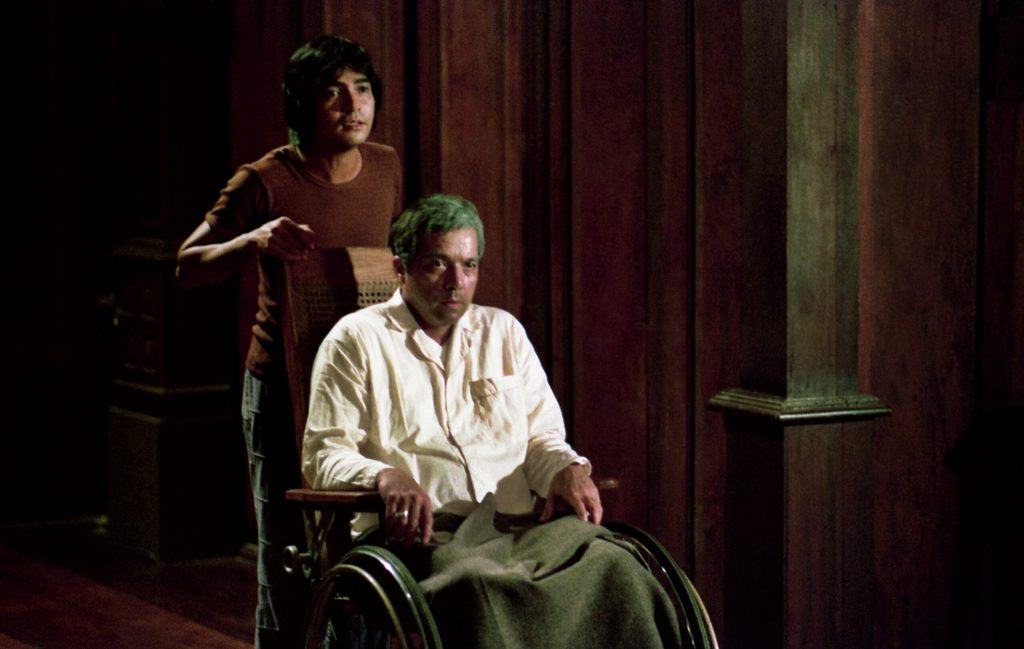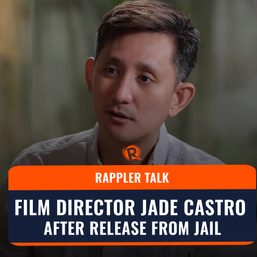SUMMARY
This is AI generated summarization, which may have errors. For context, always refer to the full article.
![[Only IN Hollywood] Mike de Leon on ‘Itim’ premiering in Cannes almost 50 years later](https://www.rappler.com/tachyon/2022/05/mike-de-leon-itim.jpg)
LOS ANGELES, USA – After watching Mike de Leon’s Itim (The Rites of May) in Manila in 1976, I could not shake off the film’s quietly spooky impact. As a budding film lover in Manila in the late ’70s, I was hypnotized by the film’s haunting images and subtly creepy atmosphere.
Even today, I still vividly remember how Mike’s feature directing debut was vastly different from the loud, gimmicky horror movies that Philippine cinema was churning out for decades. Many years later, Itim’s effectively understated, chilling scenes still give me the goosebumps.
Co-written by Clodualdo “Doy” del Mundo Jr. and Gil Quito, Itim – voted the best film of the decade (1970-1979) by Gawad Urian – follows a man (Tommy Abuel) who meets a woman (Charo Santos-Concio) possessed by her sister’s spirit (Susan Valdez-Le Goff), leading to the revelation of what happened behind the latter’s mysterious disappearance.
As a film per se, Itim was a welcome addition to the works of filmmakers led by Lino Brocka and Ishmael Bernal in the 1970s, which would be considered later as the second golden age of Philippine cinema.
Bernal’s Nunal sa Tubig, Brocka’s Maynila Sa Mga Kuko ng Liwanag (De Leon’s first cinematographer credit), Mario O’Hara’s Tatlong Taong Walang Diyos, Itim, and more were a breath of fresh cinematic air in the Philippines, where hysterical, shallow movies were often the norm.
I became fascinated with De Leon, a bespectacled, boyish-looking director who went on to make other films in other genres, each one of them I loved, including Kung Mangarap Ka’t Magising, Kakakaba Ka Ba?, Kisapmata, Batch ’81, and Sister Stella L.

I was glad, not surprised, when the Cannes Film Festival sent an email announcing that a restored version of Itim will have its world premiere as part of Cannes Classics this May in the 75th edition of the prestigious fest on the Croisette.
In its email, Festival de Cannes wrote: “Restoration done using the original 35mm negative and optical soundtrack, stored at the British Film Institute. The negative, scanned in 4k, benefited from a 2k digital restoration done at the Immagine Ritrovata Laboratory, Bologna.”
“Color grading was supervised by the director, Mike de Leon, and his co-director of photography, Rody Lacap. This presentation is a preview of the French release of Mike de Leon’s entire restored body of work, slated 2022-2023.”
Mike de Leon
After several back-and-forth emails, Mike, a very private man who has grown increasingly reclusive over the years, agreed to a rare interview via email. To say that this cineaste journalist was elated is an understatement.
On how he and Rody supervised the color grading during the restoration process, Mike explained, “The initial grading of the film was supposed to be done at the local Wildsound Studios. We had devised a system wherein I could supervise the grading here in Manila and Wildsound would send the files back to Ritrovata for final tweaking and remastering.”
“This was very convenient because it meant that people involved in the production like Rody or the late Cesar Hernando could be present with me as we graded the film.”

“But the graded file would always have to pass through Davide Pozzi in Bologna. Through the years, Davide and I developed a close working relationship and a deep friendship.”
“With Itim, however, there was the pandemic to contend with. I did not want to go to the studios and Rody felt the same. So they did the grading online. But I was not happy with the result.”
“I think Itim has a special look, unique in local cinema because I experimented a great deal in the lab while we were shooting it. Finally, I decided to turn over the entire grading process to Ritrovata and we sort of calibrated my desktop monitor.”
“I did an entirely new guide that worked great in doing the final grading with Ritrovata. I worked closely with Caterina Palpacielli, who was in charge of the project and Roberta Micale, their colorist.”
“Then, Davide previewed the final result on their 4k screen and made a few changes to give the film back its cinema look. I hope to see it on the big screen when the film is premiered in Manila in July (together with the restored Kisapmata).”
But what Mike has seen impressed the filmmaker noted for his brilliant visual sense. “The restoration was amazing. In the first place, the film, together with Maynila, had been kept at the British Film Institute Archive since the late ’70s. Both films were preserved well.”
“Itim is a ‘dark’ film and I used very little light in the original photography. Instead, the dark parts were boosted in the lab.”

“I was pleasantly surprised that the details in these dark areas were still intact and this time, with digital grading, these parts could be manipulated separately, something that was impossible in film grading.”
“To make a long story short, with the film very carefully digitally cleaned up, the restored Itim looks even better than when it was first released 46 years ago.”
“I’m happy, of course, but did not expect it, Itim being my first feature,” Mike said about his film being screened in the film festival, considered the most prestigious. He is one of a few filmmakers who had two films, Batch ’81 and Kisapmata, premiere in Cannes’ Directors’ Fortnight in the same year (1982).
Mike added, “Vincent Paul-Boncourt of Carlotta Films believed in the film, and in spite of my protestations, submitted it to Cannes Classics. I was told that the initial reaction to the film was very good.”
The director-grandson of Narcisa “Sisang” de Leon, the co-founder of LVN Studios, one of the Philippines’ major film companies in the ’30s to ’50s, who usually loathes talking about the past, looked back on his journey in cinema.
“I did not set out to become a director,” declared the son of Manuel de Leon, who produced such early classics as Anak Dalita and Badjao. “I enjoyed cinematography, especially creating something ‘new’ in Philippine cinema, when I photographed Maynila.”
“But in the early ’70s, before Martial Law was declared, I was already filming random events in Super 8mm, 16mm or even 35mm while working in the LVN lab.”
“I wanted to do some sort of compilation film. I didn’t know what it was called then – you know, like a music video today but I wanted to do a juxtaposition of conflicting images, like Lenten flagellants, the First Quarter Storm rallies, obese shoppers at newly opened supermarkets, etc.”
“I didn’t know much about editing, not even screenwriting, but I had a title for the non-existent film, Sa Bisperas. On the eve of something momentous, anarchic because that was the situation shortly before the declaration of Martial Law.”
“That was what I encountered upon returning from Germany (where he studied art history at the University of Heidelberg). The film was never made because I got picked up by the military and accused of making ‘subversive’ films. Martial Law had just been declared. If I do get to make a new film, I intend to use this same title (Sa Bisperas).”
“After Maynila, I made a short film called Monologo (now lost), shot in Baguio. There was no dialogue and the film had only one character. And I used the camera to tell the story. It was like an homage to Antonioni’s Blow-Up. It eventually morphed into Itim.”

“As I said in Doy del Mundo’s documentary about the making of Itim, I was not sure about becoming a film director, but after Monologo, I was sure I wanted to become one.”
“Lino was the first to watch the rough cut of Monologo and noted my skill in telling the story using the camera. He gave me a lot of encouragement and even said so publicly or in some article, ‘to let it be known that I worked with Mike first.’”
On his experience working with Lino as the producer and cinematographer of Maynila, a social-realist drama, and how it prepared him to direct, Mike said, “I wasn’t interested in the socio-political implications of Maynila. I just wanted to photograph the film and give it a naturalistic look, using techniques I learned while working in the lab and shooting experimental clips.”
“But I wanted to do a film that was in the tradition of my father’s Anak Dalita, and after Lino’s success with Tinimbang, I thought he could do it again with Maynila. It didn’t work. Maynila was too depressing.”
“In major scenes, I watched how Lino directed his actors but then I realized that I was not and could never be an actor’s director. First of all, I can’t act. In time, I developed my own style in working with actors and treating film acting as one of the elements of the totality of a film, which is, after all, a director’s medium.”
Asked about the release of his films in France this year and 2023, de Leon replied, “Carlotta Films acquired all my films, except Sister Stella L. which has remained unrestored, but that’s another story.”
He added, “Even Avellana’s A Portrait of the Artist as Filipino – whose camera negatives were found intact in the LVN archive and was bequeathed to me by my father before he passed – could be released, hopefully with some other LVN titles restored by ABS-CBN.”
Charo Santos-Concio, Tommy Abuel, and Susan Valdez-Le Goff
What I also still distinctly remember about Itim were the effectively understated performances of Charo, Tommy, Susan, Mario Montenegro, Mona Lisa, Moody Diaz, and Sarah K. Joaquin.
Itim marked Charo and Mike’s first time as an actress and director, respectively. She recalled, “It was Mike’s directing debut but he already worked as a cinematographer before while it was my very first film. Maybe because of this, Mike was very kind to me, even shooting the film chronologically, which helped me ease into the role gradually.”
“Mike was the perfect newcomer director because he was so hands-on. He coached me in every scene, rehearsed lines with me, and even explained the camera angles and shots. It was both a movie role and a crash course for me in filmmaking.”
“Working with Mike is to see a genius in action. He storyboarded the entire movie in his head, even before the first shot. He expects perfection from everyone.”
“You cannot help but be engaged because your director is so focused. I see that it is not work but pure passion for him. You can see the passion in every frame of the movie.”
Tommy, on the other hand, already had a string of film and stage credits to his name when he shot Itim. “Since Itim was Mike’s first directorial job, I remember he was mainly concerned with the technical aspects of the film such as camera angles, shots, lighting, etc.,” Tommy shared.
“And since most of the members of the cast were experienced actors, he left us to ourselves in the acting department. I guess Mike trusted us that much.”
“But with Charo Santos, since it was her first film, he assigned Mel Chionglo, who was also our production designer, to be her acting coach. I guess he did a very good job since Charo won a best actress award (Asian Film Festival)!”

Susan also made her screen acting debut via Itim. Now based in the US, she said, “Itim was the first movie I made. I had just won a place in the Mutya ng Pilipinas. So, it must have been the commercial I made for Palmolive Soap that got Mike interested in casting me.”
“I had a non-speaking role.” She cracked, “Maybe my Ilonggo accent was too strong?”
“I don’t know if the character was conceived as non-speaking. I don’t remember receiving a script.”
“On my first day on the set, I was naturally nervous but Mike made me feel comfortable. He gave me the story of the movie. He provided context for the scene we were filming.”
“He gave me the background of my character, the story, and my character’s role in the story. Pretty comprehensive!”
“He described the scene, explained what went before it. Before filming, he would tell me what emotion he needed from me and I would, of course, bring up my own personal experience that brought out the needed emotion.”
“One particular scene where I had a very difficult time preparing for was the scene I had to cry tears. At that time, I can’t bring out tears easily.”
Susan quipped, “Not enough life experiences yet?”

“So, I asked Mike to give me time to build up. I know I spent a lot of time getting the tears out but Mike patiently waited for me. I remember the whole crew was quiet. There was minimal movement.”
“The set was ready and just waiting for me. Mike allowed me to build the emotion and only started filming when I gave him the cue. I was really appreciative of the support he gave me.”
“That’s how I remember Mike. He was very patient. Meticulous in preparing a shot. He was particular with how the lighting was set up. Lengthy waiting time when he sets up the lights which shows how much of a consummate director he was.”
“On our off hours, he was a friendly, easy man to engage with. He chatted with us at meals or when we were just hanging out.”
I asked this trio of actors about their reaction to the fact that 46 years later – after almost half a century – a fully restored version of Itim will world-premiere in Cannes.
“To me, a classic is a piece of work that never loses its power, even through time,” began Charo, who also became a film producer and ABS-CBN’s top executive. “Any generation can watch Itim, and it will still have the power to move them in the same way it moved audiences almost half a century ago.”
“Itim deserves its Cannes premiere, and I believe it will astound audiences in its new life. I feel so lucky to be a part of such a significant film, but all the credit goes to Mike who labored on this restoration for years.”

“Just yesterday, he told me that the restored version looks better than the original theatrical version. I cannot wait to see Itim again. It is a window to another time, another life, to a golden age of cinema we have never seen before and may never see again.”
Tommy, for his part, said, “I am happy and elated to hear that the film will world-premiere in Cannes Classics 2022. I am mighty proud to be part of a film that is now considered a classic.”
“I am very happy that Itim is included as part of the Cannes Classics,” Susan reiterated. “It is a very good example of the excellence of Philippine talent – Mike de Leon is an exceptionally talented director. Charo Santos and Tommy Abuel are very good actors.”
“All the supporting actors are seasoned veterans. I have very fond memories of making the movie, learning from Mike as well as the whole cast. I am very fortunate to be surrounded by them, considering it’s my very first movie. Itim set the standard high!”
Clodualdo ‘Doy’ del Mundo Jr. and Gil Quito
Doy shared the genesis for his and Gil’s script, which stands the test of time. “Mike did a short film entitled Monologo, with a photographer as the main character. It has the same feel and mysterious atmosphere as Itim.”

“At that time, Mike was learning and experimenting with the medium. When he decided to direct a full-length film, Monologo became the genesis.”
Gil recalled his reaction when he watched the finished film for the first time. “I was most impressed with how Max Jocson’s music and the film’s sparkling visual quality worked so well together.”
Doy remembered, “It was a wonderful experience. We were all newbies then. Mike, Gil, Ely Cruz the cinematographer, Max Jocson as music composer, Mel Chionglo as production designer, Ting Nebrida as script continuity guy and rehearsal assistant to Charo and Tommy, and Charo as actress.”
“I remember seeing Lino Brocka during the premiere screening and he congratulated us, ‘Hoy, ang galing ‘nyo.’” Coming from one of the masters of Philippine cinema, that was a huge compliment.
I asked the duo what they remember about their concerns, anxieties, or worries, if any, when they were co-writing the script.

Gil answered, “I remember the writing going smoothly and without much anxiety, except when it came to deciding how the film would end. It somehow wouldn’t come, no matter how we twisted our brains into pretzels. It became a source of great stress.”
“At that time, I was attending the spiritist séances in Quezon City led by Becky Gutierrez. (Among the other regulars were Nestor de Villa and his wife, Marilou Cacho.) I had introduced Becky to Mike, who hired her as an on-set consultant on all things psychic. Her presence proved to be fortuitous.”
“Mike or Mel Chionglo (working as a production designer, in his first film job) struck on the idea of having Becky write down the prayer/incantation in her real-life séances. This became the catalyst for the last scene. Funny how, when one watches Itim, the ending appears so fated and inevitable.”
Doy stressed, “I don’t remember the details. What I do remember is that it was an exciting experience. The writing of the screenplay was just the start. Getting it translated into film was the challenge – which Mike passed with flying colors.”
“We were all practically new to the filmmaking enterprise. I guess that helped. Everybody wanted to show what they could do – from production design (Mel), performance (Charo, Tommy, Susan), editing (Ike), to music score (Max).”
The two highly respected screenwriters also shared their reactions upon seeing their characters come to life on the big screen for the first time.
Gil said, “Having seen Tommy in his quietly eloquent acting in Maynila, it was not hard to imagine him in the role of that withdrawn, young man awkwardly reaching out to his paralyzed father (played beautifully by Mario Montenegro).”
“It was Charo’s acting debut. It soon became clear that she was perfect for the role of the troubled and mysterious woman. Her voice, however melodious-sounding, seemed to be coming out of a deep and painful chasm.”
Doy commented, “I never imagined the main roles with established actors. Mike saw the characters in Charo, Tommy, and Susan. And being familiar with the iconic LVN actors, he cast Mona Lisa and Mario Montenegro. That was a good directorial decision.”
Gil and Doy offered their take on how the ’70s fermented masterpieces like Itim and Insiang.
“It was the Martial Law period,” Gil said. “It was dangerous to openly denounce the government, though there were extrajudicial killings, censorship was arbitrary, the economy was deteriorating, and there was rampant looting of the national coffers.”
“It’s somehow ironic that the ‘second golden age of Philippine cinema’ happened during Martial Law.”

“Marilou Diaz-Abaya, one of the great directors of that period, weighed in on this paradox: ‘(It was) because both artist and spectator were in a state of ferment. I believe that in times of deprivation, you’re hungry not only for food or the basics but also for expression. Or for a release of anger.’”
Gil quoted a page in the Urian Anthology book: “Both the artist and spectator could find no better time than the period of repression to experience the almost instinctive or intuitive communication and bonding…. It wasn’t about the movie stars in the Martial Law years. It was about the directors. It was about Brocka and Bernal.”
“There was also a lot of escapism, be it through sex movies, drugs, or spiritist séances. There were the arthouse films that the then out-of-reach festivals like Cannes were launching, films that were for the most part unavailable in the Philippines (this was way before the digital revolution).”
“Usually, the only way to experience them would be vicariously, by reading the reviews in Time or Newsweek. However, there were the odd arrivals, washing up now and then almost randomly.”
“One had to be quick to catch them as they were prone to disappear in a day or two. Among them was Antonioni’s Blow-Up, which became a major influence on Itim.”
Doy remarked, “The ’70s marked the entry of a new generation of filmmakers. Brocka and Bernal paved the way when they broke into the industry in 1970.”
“Then, Brocka established Cinemanila, which produced his film Tinimbang Ka Ngunit Kulang. That film encouraged the formation of more production companies and the entry of new filmmakers.”
“Mike de Leon established Cinema Artists and produced Maynila. Then, he decided to direct and made Itim.”
“The ’70s introduced not only new directors but screenwriters as well, production designers, cinematographers, editors, music composers, and actors. It resulted in the renaissance of Philippine Cinema.”
Vincent Nebrida
Vincent had a front-row seat in the filming of Itim. Popularly known as Ting in the industry, he went on to become a screenwriter and entertainment executive in the US, then went back home and became a producer and studio president.
He recalled, “I just graduated from Ateneo in April 1976 when my professor-mentor, Fr. Bert Ampil, told me that one of his former students, Mike de Leon, was looking for a fresh graduate intern to work with him on his first film, Itim.”
“I went to LVN and was interviewed there by Mike, and was hired to report to his assistant director, Paquito Maclang, if I recall correctly.”
“We stayed in Mike’s (ancestral) house in San Miguel, Bulacan and we shot the film there for at least two months. Again, if I remember correctly, it was in August and September of 1976.”
“Mike was truly impressive as a first-time filmmaker. He was mabusisi in terms of lighting and camera set-ups. You can tell he studied cinematography, and that the film would be a visual masterpiece.”
“Working on Itim was what made me decide to have a life in film. As the script continuity person, I was often asked by both the stars Charo and Tommy questions like, ‘Saan ba ako nakatingin kanina’ and ‘Ito ba ang suot ko sa previous scene,’ because they truly cared about the film.”

“I also became friendly with its supporting cast, especially Mona Lisa who entertained us with stories from the early days. And of course, it was through this film that I met its talented screenwriters, Doy del Mundo and his brother-in-law, Gil Quito.”
“Years and decades later, Doy invited me to a preview screening of K’na The Dreamweaver, the first film of his daughter Ida del Mundo. And it was here that he introduced me to Sir Nando Ortigas and Ed Rocha, who both executive-produced K’na and made it happen. The rest is history.”
Mike, who is turning 75 on May 24, reflected, “What I did not expect was that at this late stage of my life, my work will be rediscovered again, and in the event that I make one more film (something I’m planning to do soon), I don’t have to start from scratch.”
“My films are niche films anyway, as Tony Rayns told me. Tony wrote the preface to my book, Mike De Leon’s Last Look Back. It was a mistake to include them in streaming platforms.”
“Carlotta Films will market them in Blu-ray and DVD for serious film collectors. He (Vincent Paul-Boncourt) also plans to have theatrical screenings in France for several of the films. Hopefully, after Cannes, and perhaps New York, my films will be picked up by other discriminating distributors in other territories, including the Philippines (I hope).”
I also do hope and pray that Mike will gift us with another film, and another, and another. – Rappler.com
Add a comment
How does this make you feel?





There are no comments yet. Add your comment to start the conversation.